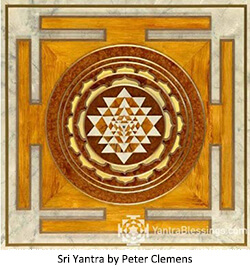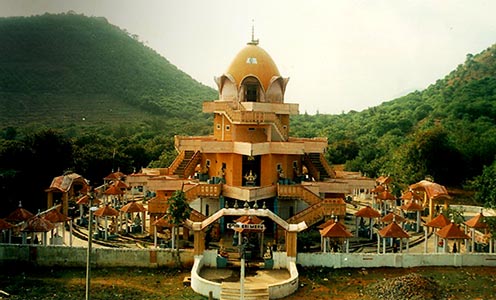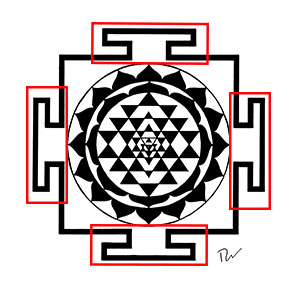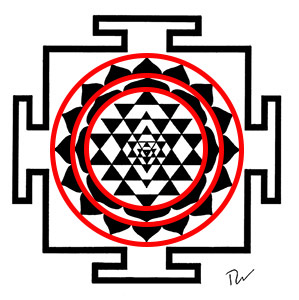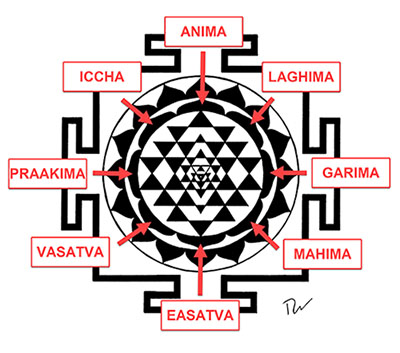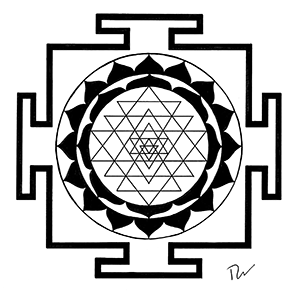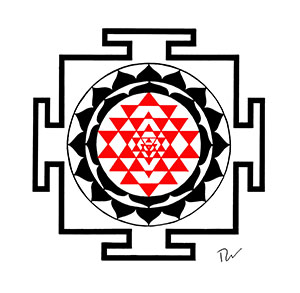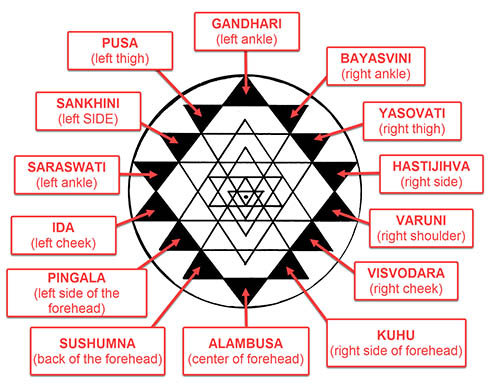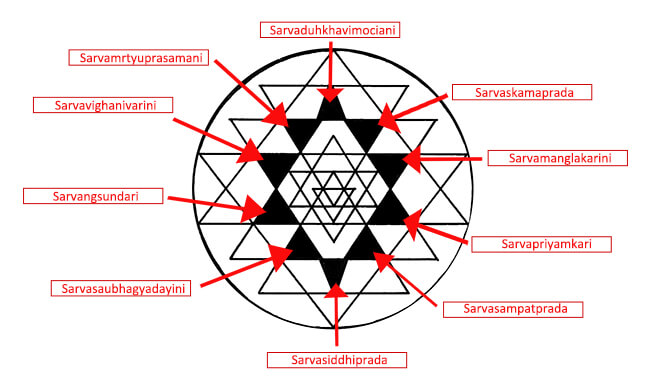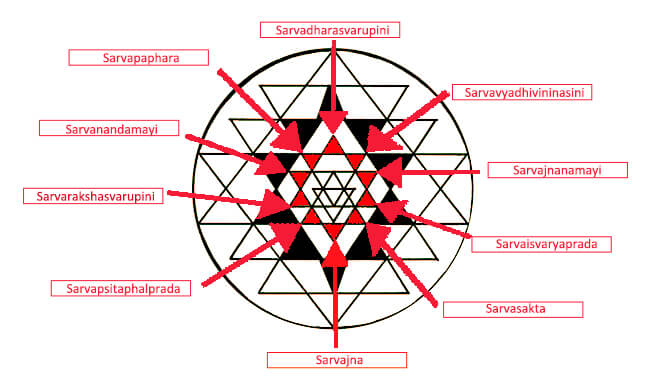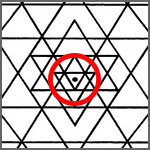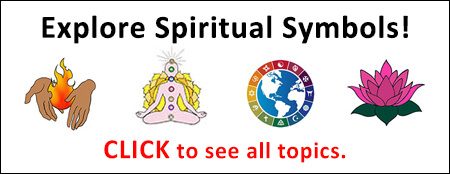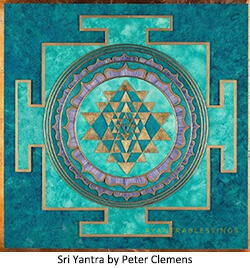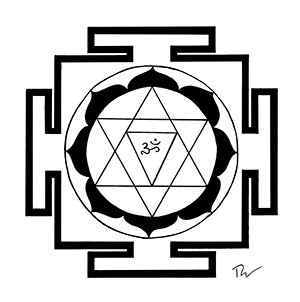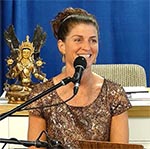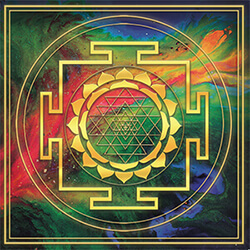
Sri Yantra Comprehensive Guide
Meaning of the World's Most Powerful Wealth Symbol
The Sri Yantra is possibly the world’s most powerful symbol. This ancient symbol is sometimes referred to as the Mother of Sacred Geometry or the Holy Wheel. The Sri Yantra is also called the Queen of Yantras because it is a symbol of the divine mother, source of all energy, power, and creativity.
Names of the Sri Yantra
Other names include alternate spellings such as Shree Yantra or Shri Yantra. This amazing geometric design functions on multiple levels. This article covers the history, symbolism, and spiritual practices associated with the Sri Yantra.
Share this page with a friend!
Table of Contents
Symbolism of the Sri Yantra
First of all, the Sri Yantra reveals universal patterns of energy. These patterns are a clear path towards spiritual acceleration. On another level, the Sri Yantra is a powerful wealth symbol, creating abundance in many forms. In addition, the Sri Yantra is a visual map of the spiritual path.
Effects of the Sri Yantra
The Sri yantra stimulates the pineal gland, creating electrical currents in the body. This helps to raise the kundalini energy. Raising the kundalini energy is the goal of many spiritual practices. The kundalini energy is coiled in the root chakra and moves to the crown when enlightenment is realized.
What Is a Yantra?
The word “yantra” means “instrument” or “machine.” The word “sri” means abundance, wealth or splendor. The meaning of “yantra” is sometimes translated as “a tool for the mind.” Yantras are an important visual aid for meditation, for mastering the flow of energy in the body, and for understanding the energetics of the universe. The Sri Yantra is by far the most popular of the Hindu yantras.
History of Yantras
Yantras are geometric forms or symbols that have been in use for thousands of years. In fact, there have been stones found in India with drawings of yantras dating back 10,000-12,000 years. The forms may be even older, inherited from ancient civilizations.
Sri Yantra Construction
Yantras have a central form with shapes radiating outward. These shapes include triangles, circles, hexagrams, pentagrams, octagons, lotus petals, and tridents. The Sri Yantra is constructed using these building blocks in concentric layers. Each shape has its own symbolic importance. The meaning of a yantra varies based on the details of the shapes used as well as the overall structure of the image.
Forms of Yantras
Yantras have three main forms. Each yantra is connected to one or more Hindu deities. The first yantra form is circular, form similar to a mandala. Secondly, yantras may take the form of squares featuring numbers and letters. The Hanuman Yantra is an example. Learn more about the Hanuman Yantra.
Yantras and Pyramids
A traditional yantra is actually a three dimensional form. This form creates a type of pyramid. Sculptures and bas relief carvings of yantras are also popular. These are made from many different materials: metal, stone, wood. The three dimensional forms may be converted to drawings to extend their uses. Small yantras can be placed on an altar as a meditative focus.
Sacred Temples and Yantras
The pyramid yantras are called merus. Entire buildings (temples, cathedrals) have been constructed as yantras. This is thought to channel divine energy. The architecture itself becomes a conduit to higher dimensions. For example, the Sahasrakshi Temple in Andhra Pradesh, India, was built in the shape of a Sri Meru Yantra. See image below.
Temples and City Planning
In ancient India, having a temple properly positioned within a village was the most significant part of aligning the inhabitants’ lives with the divine. The temple was built first. Residential dwellings and buildings for businesses and government facilities were constructed afterwards. In this way, villages, towns and cities are constructed around a central temple.
Yantras and Tantric Teachings
Most teachings concerning yantras are found in the Tantras, books written one to two thousand years ago. The Tantras were originally part of an ancient oral tradition. The teachings themselves are probably several thousand years older. As a spiritual tool, yantras are a central part of the ancient practice of using visual aids for meditation.
Sri Yantra and Hinduism
The Sri Yantra is the most well-known and widely recognized of the Hindu yantras. The Sri Yantra comes from the Vidya school of Hinduism. This sacred form is composed of nine interlaced triangles. The four upward triangles meet five downward triangles to form a star tetrahedron. Like other yantras, the Sri Yantra is viewed as a dwelling for the sacred energy of a specific deity. The goddesses Lalita and Lakshmi are closely associated with the Sri Yantra. In addition, Shiva is said to embody this powerful yantra.
Yantras and Mandalas
Yantras are similar to the more well-known Buddhist mandalas. As noted above, the terms can be used interchangeably, particularly for circular yantras. However, there are several key differences. Mandalas tend to be more complex, sometimes depicting divine beings, human activities, and the heaven world. In other words, mandalas are figurative. On the other hand, yantras are more abstract.
Geometric Forms of Yantras
Yantras tend to be linear and geometric. Yantras in Hinduism are generally simpler than the mandalas often associated with Buddhism. Yantras are composed solely of geometric forms, Sanskrit characters, and organic forms such as lotus petals.
Yantras and Mandalas
Another difference between mandalas and yantras is the intention. Mandalas are often made from fragile or perishable materials and destroyed after creation to emphasize the impermanence of the world. The creation process itself is a meditation. On the other hand, yantras are retained as an ongoing channel and receptacle for divine energy.
Yantras and Sound
In addition, yantras are directly associated with particular sounds or mantras. Yantras are believed to depict the patterns of these sounds in matter. This can be demonstrated with modern cymascopes. A cymascope is a scientific instrument that reveals the patterns created by sound in sand, water, or other substances. This connects the unseen world of sound with the physical or visual dimension. More information about yantras can be found in my book Vocal Medicine.
Yantras and Modern Science
As noted above, cymatics is a branch of research that explores the power of sound to change matter. Sound creates either stunningly beautiful or discordant patterns in sand, water, and other materials. Thus, the science of cymatics relates directly to the art of yantras.
Founder of Cymatics
The term “cymatics” was coined by Hans Jenny (1904-1972), a Swiss researcher. Jenny explored the nodal patterns formed by materials subjected to continuous sound. The patterns for specific sounds are remarkably like the forms depicted in traditional yantras.
Learn more about One Word Mantras!
Sri Yantra and OM
Each yantra has a specific sound and potential spiritual power. The Sri Yantra is the visual equivalent of the sound OM. This Sanskrit seed syllable represents the hum of the universe. Learn more about the power of seed or bija syllables in the article One Word Mantras.
Triangles and the Sri Yantra
The Sri Yantra represents the union of the masculine and feminine. This is symbolized by nine interlaced triangles. These triangles meet in a star tetrahedron, creating forty-three intersecting triangles. These triangles are organized in nine concentric levels radiating out from the central bindu point. The meaning of every aspect of the Sri Yantra is covered in detail below.
Sacred Geometry & the Sri Yantra
Each yantra has a specific action based on the form and symbolic meaning. For example, a yantra may be used for protection outside of a dwelling or as a personal talisman. Every aspect of a yantra is purposeful and meaningful. The circles, triangles, lotus petals, squares and other forms carry a specific energy.
Sri Yantra and the Five Elements
In addition, these geometric symbols are connected to the five elements in the Ayurvedic tradition. The Vedic elements include earth, water, fire, space, air. Each of these energies have a transformative power. These energies are discussed in depth in the article Five Element Mantras.
Sri Yantra and the Soul’s Journey
The sum total of the energy and symbolism of the Sri Yantra creates a story of the soul’s journey. To follow the circuits of spiritual energy embedded in the Sri Yantra, we begin in the outermost square. We travel towards the middle, ending with the dot or bindu in the center.
Square Meaning & the Sri Yantra
Sri Yantra meaning begins with the outer square representing stability. This creates a solid foundation for the yantra. The square is a symbol of condensation and manifestation in the world. The square also creates a boundary around the inner world. The Sanskrit name for this outer square is Trailokya Mohana.
Square Symbolism
Most yantras have a square as their fundamental form. The numerical equivalent, of course, is four. The square connects to the earth element in the Vedic tradition. The square is also the base for the root chakra symbol. Learn more in Chakra Symbols.
Gates Into the Sri Yantra
On each side of the yantra are gates that open up to invite the viewer into the center of the yantra. There are four doorways or gates protruding from the square at the circumference of the Sri Yantra. These gates are thresholds between the inner and outer worlds. The Sri Yantra can be viewed as a map of man’s spiritual journey from the outer to the inner along designated circuits.
Circle Meaning in the Sri Yantra
The three concentric circles in the Sri Yantra bring focus to the visual form. This, in turn, focuses the mind of the viewer. A circle is a primordial form that cannot be further reduced. At the smallest size, the circle in the center of the yantra becomes a point or the bindu.
Sri Yantra Circle and the Bindu
This is the same name given to the traditional, decorative dot placed between the eyebrows. The bindu marks the place of the third eye chakra. Learn more in the article Third Eye Chakra Meaning. See section below on circle symbolism for more information about the significance of the bindu.
Circle Symbolism
The circle symbolizes infinite space and expansiveness. This is the Vedic element of space or akasha. The circle also represents the cycles of nature at all levels from the atom to astronomy. The central quest of spirituality is to experience the Oneness of these realms.
Circle Meaning in Hinduism
The Hindu vision of the universe is a set of concentric circles. A metaphorical spider sits in the center, both spinning and reabsorbing the threads of reality. The circle represents the One force that both creates and unifies all things. The circle contains the notion that there is no end and no beginning to time. The numeric equivalent of the circle is zero.
Three Circles of the Sri Yantra
The importance of the number three is prominent in both Western and Eastern religious philosophies. The Western trinity is the Father, Son and Holy Spirit. The Hindu Trinity is Brahma (Creator), Vishnu (Preserver), and Shiva (Destroyer). The all-pervasive Divine Mother or shakti is the force animating the three persons of the Hindu trinity.
Lotus Flower Meaning in the Sri Yantra
The lotus symbolizes purity, enlightenment and transcendence. In a yantra, the lotus is usually viewed from the top, with the petals extending out on the rim of a circle. Metaphorically, the lotus illustrates the unfolding of the divine essence within.
Lotus Flower in Hinduism
The lotus is like the navel of creation. In fact, the lotus is sometimes depicted as springing from the navel of Vishnu and giving birth to Brahma, two of the gods in the Hindu trinity. The lotus is equated with beauty, prosperity and the eternal.
Lotus Meaning and the Heart
The lotus is also a symbol of the heart, especially the inner or secret chamber of the heart. This is sometimes called Brahma’s cave or the city of Brahma in the East or the inner castle in the West. This is the core of being that remains untouched by everyday living.
Lotus Petals in the Sri Yantra
The Sri Yantra features two rings of lotus petals. The inner ring has eight petals. The outer ring has sixteen petals. Interestingly, the throat chakra symbol also features a lotus with sixteen petals. Learn more about the throat chakra symbol in Chakra Symbols.
Lotus and the Power of Duplication
The lotus petals represent creation and life force. The duplication of the petals from eight to sixteen exemplifies this principle. Each petal has its own siddhi or power. Let’s take a look at the meaning of each lotus petal in the Sri Yantra.
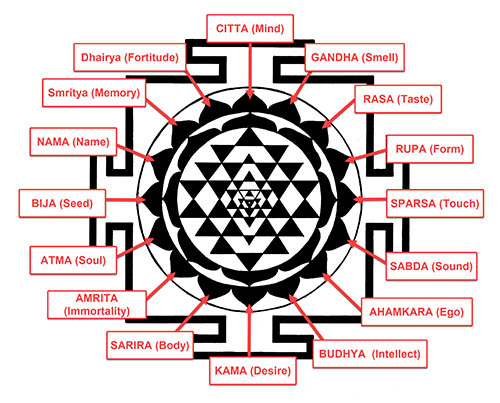
Outer Circle of 16 Lotus Petals
The outer circle of 16 petals in the Sri Yantra symbolize the ten organs of perception (ears, skin, eyes, tongue, nose, mouth, feet, hands, arms, genitals) and the five Vedic elements (earth, fire, water, space and air). The final petal symbolizes the mind’s ability to integrate all of these elements.
Forms of Sensory Knowing
This outer lotus has the name Sarvasaa Paripuraka in Sanskrit. These elements are actually considered to be a form of false knowing since they are purely sensory. However, they are necessary at the beginning of the spiritual journey. Eventually they are replaced by “all knowing” through inner experience.
Meaning of Each Outer Lotus Petal
In Sanskrit, these outer petals are Kama (Desire), Budhya (Intellect), Ahamkara (Ego), Sabda (Sound), Sparsa (Touch), Rupa (Form), Rasa (Taste), Gandha (Smell), Citta (Mind), Dhairya (Fortitude), Smritya (Memory), Nama (Name), Bijha (Seed), Atma (Soul), Amrita (Immortality) and Sarira (Body).
Inner Circle of 8 Lotus Petals
The Sanskrit name for the inner circle of lotus petals is Sarva Samkshobahana. The inner ring of eight lotus petals in the Sri Yantra each have their own symbolism. The petals represent siddhis or yogic powers. Specific deities embody each of these powers. These are sometimes viewed as specific human activities: speech, motion, grasping, revulsion, enjoyment, attraction, equanimity and excretion.
Meaning of Inner Circle Petals
This inner circle is referred to as the “Agitator of All.” Mastering the qualities of each petal through meditation, self-observation and individual effort can grant both worldly and spiritual success. The specific meaning of the petals can be outlined as follows:
ANIMA: This word means smallness or vulnerability. The siddhi or power conveyed is closely related to honesty with yourself and others. This is the ability to connect to yourself internally.
LAGHIMA: Laghima means bigness in the sense of taking the maximum amount of responsibility in your own life. This also conveys a connection to the largest self or the universe.
GARIMA: Garmina means heaviness, grounding, an anchor or a weight. This is a positive sense of being rooted to the earth, being unmoved by circumstances and sticking to your purpose.
MAHIMA: Mahima means creativity. This yogic power is a direct connection to a free flow of ideas and the resulting accomplishments.
EASATVA: Easatva means godliness and purity. This is the power of courage and confidence that comes from knowing you are pursuing your own highest calling in wisdom and love.
VASATVA: Vasatva means subjugation, bringing under control and conquering the self. This is the ability to overcome obstacles in life versus utilizing violence or overcoming others.
PRAAKAMYA: Praakamya means fulfilling the objective. This involves creating a strategy and a sense of conviction so strong that you feel that all that is necessary has already happened.
Sri Yantra Triangles & the Energy Body
When the limitations of the physical body and its attractions represented by the two rings of lotus petals have been overcome, a greater understanding of the subtle or energy body is the next stage of spiritual progress. Again, the Sri Yantra is a key tool revealing this knowledge.
Energy Channel Symbolism
The energy body is sometimes called the psychic body or the finer body. This body is composed of subtle nerves, energy channels, and the vital energy or prana. This energy gives life to the physical body. Each of the overlapping triangles in the Sri Yantra is associated with a particular aspect of the energy body.
Sri Yantra Energy Circuits
There are four circuits of overlapping triangles. The first contains 14 triangles. The next two circuits contain 10 triangles each. The innermost circle contains eight triangles. Each of these circuits and their corresponding meanings are discussed below.
Triangle Meaning in the Sri Yantra
The most basic Sri Yantra meaning is the union of the divine masculine and feminine. This is symbolized by the nine interlaced triangles. The upward triangles meet the downward triangles in a kind of star tetrahedron. As mentioned above, there are four upward triangles and five downward triangles.
Forces Represented by Triangles
Each triangle contains within itself three points. These represent the three basic forces in the universe: creation (sattva), preservation (rajas) and dissolution (tamas). These points and processes relate to the Hindu Trinity of Brahma, Vishnu and Shiva. The Divine Mother (Shakti) is the force behind each of these that enlivens them and gives them power. The symbolism of the trinity is repeated in the three concentric circles of the Sri Yantra.
Nine Stages of the Sri Yantra
The Sri Yantra is sometimes called the Yantra of Nine Triangles (Nava-Yoni Chakra). The spiritual journey depicted in the Sri Yantra occurs in nine stages. Each stage corresponds to one energy circuit in the yantra. Details for the meaning of each triangle are discussed below.
Intersecting Triangles in the Sri Yantra
There are forty-three intersecting triangles created from the nine interlaced triangles. These are organized in concentric levels radiating out from the central bindu point. The triangle is the primary form that can enclose space within straight lines. Thus the triangle is the first form to emerge from chaos and create order or structure.
Downward Triangles in the Sri Yantra
A downward triangle is a symbol of the divine feminine. Downward triangles are connected to the water element. The easiest way to remember this is to think of a waterfall. In addition, water is related to the emotions. The word “emotion” can be interpreted as “energy in motion.”
Triangles and the Divine Feminine
Like water, feminine energy is free flowing and powerful. This energy is referred to as “shakti.” Downward triangles are specifically related to the Hindu goddesses Kali (Goddess of Time and Death), Parvati (Goddess of Fertility), Lalita (Goddess of Beauty), and Lakshmi (Goddess of Wealth).
Upward Triangles in the Sri Yantra
An upward triangle represents masculine energy and the element of fire. This shape can be seen in form of a campfire. In the Hindu tradition, an upward triangle is particularly associated with Shiva. The masculine force provides a counterpart and a container for the free flowing feminine energy. In the Sri Yantra, there are four triangles pointing up and five triangles pointing down.
Triangles and Planes of Existence
When numerous triangles are interlocked in the center of a yantra, each triangle represents a different plane of existence. The upward and downward triangles are symbolic of the repeating cycle of spirit into matter and matter into spirit. In the Sri Yantra, each of the nine triangles also symbolize circuits in the subtle energy body.
The Outer Circuit of 14 Triangles
The outer fourteen triangles formed by the nine overlapping triangles correspond with fourteen energy channels known as etheric nerves. Six of these etheric nerves run along the right side of the body and meet at the center of the forehead. Four etheric nerves are on the left side of the body and the other four run along the subtle body’s axis.
Triangles Linked to Hindu Deities
Each triangle also corresponds to an deity who embodies those subtle essences and is associated with that aspect of the physical body. The Sanskrit name for this outer circuit of triangles is Sarva Saubhagyadayaka. Yantras may be associated with a single deity or hundreds of deities. The connection between the Goddess Lakshmi (Wealth and Abundance) and the Sri Yantra is covered in-depth below.
The Inner Circuits of 10 Triangles
The next two circuits of ten triangles symbolize the ten circuits of pranic energy and the ten forms of digestive fire. Energy is mobilized through each of these circuits.
The Fifth Circuit of Triangles
The first set of ten triangles is the fifth circuit. The ten triangles represent the five vital currents which draw life-force into the body. The first five triangles are the vital currents: prana, apana, vyana, samana, and udana. The next five triangles represent the five medial currents: naga, kurma, krkara, devadatta, and dhananjaya.
The Sixth Circuit of Triangles
The second ring of ten triangles is called Sarva Rakshakara in Sanskrit. This set of ten triangles relates to the relationships between the ten types of pranic fire and the ten types of digestive fire. Again, each has a name for the specific vibration or personification of the divine.
The Inner Circuit of 8 Triangles
The innermost circuit of eight triangles near the bindu or center point relates to the principles of material nature and creation. The inner circle of eight triangles is called Sarva Roghahara in Sankrit.
Center of the Sri Yantra: The Bindu
The focus for meditation on the Sri Yantra is the center point known as the bindu. As noted above, the bindu is also the name of the dot painted on the face between the eyebrows. In this usage, the bindu symbolizes the third eye or center of spiritual vision. When used in the center of the Sri Yantra or other yantras, the bindu is a symbol of the Oneness of the universe. The bindu is surrounded by one small triangle called the Sarva Siddhiprada.
The Role of the Bindu
The bindu is a tool for harnessing concentration. The bindu symbolizes the source or deity for the yantra. The bindu is the gathering of the two fundamental forces in life: feminine (Shakti) and masculine (Shiva). This central dot also can be viewed as a symbol of the cosmos or as a simplified version of the yin-yang symbol where masculine and feminine are perfectly balanced.
The Bindu and the Divine
The bindu is the smallest possible circle, the “world-seed” or visva-bija. The bindu is also called the Sarva Anandamaya. The universe originates from this point. This is the metaphysical point of both origin and union with the Divine. The bindu exists both in time and in timelessness. The numerical counterpart of the bindu is zero.
The Bindu and the Third Eye
The center of a yantra radiates energy out as well as absorbs energy into itself. Ultimately the yantra is a focus for visualization, one of the fundamental powers of consciousness. This is a reflection of the development of spiritual vision associated with the third eye. Learn more about the Third Eye Chakra.
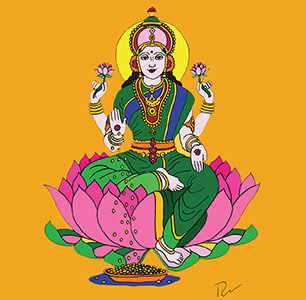
Sri Yantra as a Wealth Symbol
Specific yantras are connected to each of the major Hindu deities. Each deity can be viewed as representing a specific vibration or aspect of consciousness. See Yantra Meaning: A Comparative Guide for yantras associated with Hanuman, Ganesha, Shiva and more.
Sri Yantra and the Goddess Lakshmi
By placing attention on an aspect of God embodied in the geometric form, that energy can be multiplied and returned to the viewer. In some cases the yantra may contain the energy of a particular planet astrologically. In the case of the Sri Yantra, the primary associated deity is the goddess Lakshmi, well-known as the goddess of wealth.
Connection Between Yantras and Mantras
Since the Hindu gods and goddesses each also have specific mantras, their yantras can be invested with energy and activated by the use of these mantras. The combination of mantra and yantra creates an energy field for a specific purpose. Using the sacred geometry of yantras combined with the formulas of sacred sound known as mantras is a very powerful practice.
Root of the Name Lakshmi
The name Lakshmi is derived from the Sanskrit root “laks,” to perceive or know, and is related to “lakshana,” meaning “target” or “aim.” This suggests that abundance is achieved through perceiving and aiming for your chosen target. The Sri Yantra and the Maha Lakshmi Mantra reinforce both divine reality and the receiving of material prosperity.
Lakshmi’s Mantra
One of the primary mantras associated with the Sri Yantra is the Mahalakshmi Mantra. This is a mantra dedicated to Lakshmi and is also known as the Maha Lakshmi Mantra or the highest mantra to the goddess Lakshmi. Thus, it is viewed as a wealth mantra.
Watch nearly 400 videos on the Vocal Medicine Channel!
Maha Lakshmi Mantra
Om Shrim Hrim Shrim
Kamale Kamalalaye
Prasida Prasida
Shrim Hrim Shrim
Om Mahalakshmayai Namaha
Meaning of the Mahalakshmi Mantra
The bija syllable “shrim” helps to attract people and situations that are beneficial. “Hrim” energizes the heart. This mantra helps to manifest vitality and abundance in all of life. Hrim and shrim are often used together. Hrim is solar, shrim is lunar. “Namaha” means “it is not about me” or “not me.”
Lakshmi and the Lotus Flower
“Kamale” is a reference to the purity of the lotus flower. “Kamalalaye” relates Lakshmi to this purity and expands on the beauty of the lotus. “Prasida” is a request for blessings from the Divine Mother. “Mahalakshmi Namaha” means “to give honor and surrender to the greatest or highest form of Lakshmi.”
How to Use Yantras
The choice of a yantra depends on the aims and goals of the practitioner. Traditionally, both a mantra and yantra were chosen for a spiritual aspirant by a teacher or guru. The purpose was to find the yantra and mantra combination that would be the most effective in stimulating the devotion and life force of the seeker.
Yantras and Vastu (Feng Shui)
Yantras are sometimes used in vastu (the Hindu form of feng shui). For example, a powerful image or sculpture of the Sri Yantra may be used to correct negative configurations or influences in the environment. Historically, yantras were guarded by Hindu priests to prevent unauthorized access to them. Yantras can be created for specific purposes:
- mitigation of astrological influences
- healing of a particular diseases
- creation a spiritual forcefield
- protection from the ill will of others
- a focus for meditation and mantras
Combining Yantras and Mantras
Yantras can function in several ways. As discussed above, yantras can be used for protection. They can also be used as a means of concentrating on a particular aspects of God’s consciousness embodied in a particular deity. If you are using a mantra to shift a situation or circumstance in your life, using the yantra and mantra together will increase the effectiveness of your efforts.
Benefits of Using Yantras
Benefits of using these ancient mystical symbols include the following:
- VISUALIZATION: Focusing on a yantra helps to train the mind in the practice of visualization. In turn, mastering the use of visualization is helpful in supporting health, accomplishing goals, and creating a calm and centered attitude in life.
- ENERGY STORAGE: Some believe that the yantra itself holds spiritual energy. By chanting or focusing attention on the yantra, it can be charged like a battery. The stored energy can be utilized at a later point.
- SYNERGY: The yantra reinforces the positive effects of the associated mantra. Since the yantra is a crystallized form of the mantra, the two strengthen each other synergistically.
- CONSCIOUSNESS: The beauty and symmetry of the yantra will help to uplift your consciousness simply through gazing on the yantra or having the yantra visible in your environment.
- CHAKRA YANTRAS: The symbols for each of the chakras are also yantras. These can be used to help visualize the clearing and healing of each chakra. Learn more in the article Chakra Symbols.
More Yantra Resources
Tantra, Yantra and Mantra
There are three basic forms of practice in Hinduism that are used individually or together for self-liberation. Each of these three practices can be used or misused. The key is the intention and purity of the practitioner. For example, in the worst-case scenario, mantras can be used to cause harm or create suffering (tamasic). They can also be used purely for self-centered reasons (sattvic). Ideally, they are used for universal spiritual liberation (rajasic).
- The path of action or physical practice (tantra, physical power, nervous system, nadis)
- The path of the mind and knowledge (mantra, thought power, invocation, devotion)
- The path of will power (yantra, spiritual power, individual will, renunciation)
Functions of Yantras
Private yantras may have been derived from the larger forms used in temple construction. As depictions of universal vibrations, yantras are a type of microcosm. Rituals involving mantras and yantras can become very complex.
Yantra Rituals
The rituals may be performed only on certain days of the year. The mantras are repeated with mathematical precision for each aspect of the yantra. The rituals are done at certain times of the day, and certain types of food or offerings are given. Yantras are sometimes used in vastu (the Hindu form of feng shui) to correct negative configurations or influences in the environment.
Yantras and Astrology
Yantras may be worn as talismans or charms. Yantras can be created for specific purposes such as the mitigation of astrological influences, the healing of a particular disease, or for spiritual protection. There are yantras for each of the major planets that can be used astrologically. To learn more about astrological mantras, visit our article Astrology Mantras.
Energizing a Yantra
Yantras can be used to store divine energy much like a battery or protective shield. In addition to concentrating on a yantra when chanting or meditating, you may want to consider the following practices in association with energizing a yantra:
- Take a shower or bath to start with a sense of purity on the physical level
- Find a place where you will not be disturbed (you may want to face east)
- Light incense or diffuse essential oils (especially sandalwood, cedarwood, myrrh)
- Create some kind of altar with special objects and/or fresh flowers
- State your intention or desire (personal or universal)
- Choose a set number of times to repeat a mantra (108 is a common number)
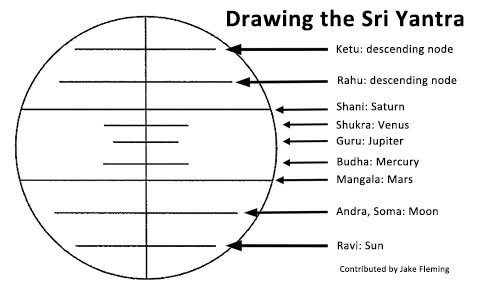
Drawing the Sri Yantra
In order to draw a Sri Yantra, join the lines within a circle as shown above in the following order:
- The ends of ravi [Sun] in the middle of shani [Saturn]
- The ends of candra [Moon] in the middle of ketu [descending mode]
- The ends of mangala [Mars] in the middle of the circle
- The ends of budha [Mercury] in the middle of rahu [descending node]
- The ends of guru [Jupiter] in the middle of bhauma [Mars]
- The ends of shukra [Venus] in the middle of soma [Moon]
- The ends of shanim[Saturn] in the middle of the circle
- The ends of rahu [ascending node] in the middloe of ravi [Sun]
- The ends of ketu [descending node] in the middle of budha [Mercury]
Contributed by Jake Fleming
Jake Fleming is a musician and producer who has created a series of instrumental and meditative works: Elephants in Space, Flute Meditations, Atmananda, and Dancing Roots. Jake’s music can be found on Spotify, YouTube and on his website.
Author Kathleen Karlsen
Kathleen Karlsen is a musician, artist, writer and speaker. She is the author of two books (Flower Symbols and Vocal Medicine) and over 200 articles. Kathleen, her husband Andrew, and their five children live in Bozeman, Montana. More about Kathleen Karlsen.

